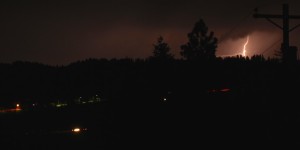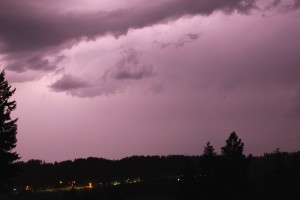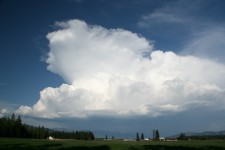The impressive lightning and thunderstorm at the end of June hammered Boundary County with dozens of lightning strikes. The next morning I found a ponderosa pine near my house with a spiraling crack around the trunk and pieces of bark scattered around on the ground.
When the storm was overhead I could hear thunder immediately after the flash and I hunkered down inside wondering if I was safe. What if I had been camping or hiking when the lightning storm ensued?

Lightning bolts may strike in one location or they may split and simultaneously strike multiple locations up to five miles apart. Each bolt can contain up to one billion volts of electricity.
Knowing what to do and where to go during a thunderstorm can definitely save your life. The approximately 25 million lightning strikes each year in the United Sates result in nearly 50 deaths and several hundred injuries.
The safest place to be in a thunderstorm is inside a substantial building with electricity or plumbing, or an enclosed, metal-topped vehicle with the windows up.
Being inside doesn’t mean complete safety. Most indoor fatalities are due to conduction. Anything that can conduct an electrical charge can carry the charge to you if you are touching it, including metal wires, plumbing, metal surfaces, windows, doors, plugged-in phones and sinks.
Concrete can also conduct an electrical charge, so don’t lie on a concrete floor, lean against a concrete wall or be standing in a garage.
To find the proximity of lightning, count the seconds between the flash and thunder and divide by five to find the miles (five seconds equals one mile).
Understanding lightning helps in determining where to seek shelter. Cloud-to-ground lightning begins with a leader heading downward towards the ground. Numerous positively charged streamers begin to rise from the highest grounded objects towards the negatively charged leader. As soon as the leader is close enough to a streamer, the leader shoots directly to that streamer to complete the lightning strike.
Lightning tends to strike elevated sharp terrain features (like mountain tops), tall trees in open areas and boats on the water. Lightning can still strike flat ground but more randomly than elevated objects.
Lightning strikes can affect us in five ways: direct strike, side flash, ground current, conduction and streamers.
Direct strikes are potentially the most deadly because the person struck becomes part of the main discharge channel during the lightning strike. Direct strikes happen most often in open areas.
Side flashes, also known as side splash or surface arcs, occur when lightning strikes a taller object (like a tree) and a portion of the current jumps from the taller object to something next to it, like a person huddled under a tree. The person acts as a short circuit for some of the energy in the lightning discharge.
Side flash strikes usually occur when a person is within one to two feet of the object being struck like someone taking shelter under a tree to avoid rain or hail.
Ground currents are created when lightning strikes a tree or another object and the energy travels outward from the strike in and along the ground surface. Anyone outside near a lightning strike can potentially be a victim of ground current, even livestock. Ground current causes the most lightning deaths and injuries.
When a person encounters ground current, the charge enters the body at the point closest to the strike, travels through the body’s cardiovascular or nervous system, and then exits at a point farthest from the strike. The greater the distance the ground current travels through a person or animal, the greater the potential for death or serious injury. So it is best to keep your feet together when standing to minimize the voltage difference.
As mentioned earlier, conduction also has the potential to kill or injure. The charge of lightning can travel long distances in wires or metal surfaces. Metal doesn’t attract lightning but it provides a path for lightning to follow.
Streamers aren’t as common for lightning injuries. As streamers move upward to meet the leader, a person could become part of the streamer if they are a taller object. While only one streamer makes contact with the leader, all the streamers discharge when the main channel discharges.
A good lightning rule is the 30-30 rule. If the sound of thunder follows a lightning flash within 30 seconds, take shelter. High danger may continue for as long as 30 minutes after the last lightning or thunder event since lightning can reach more than 10 miles from the storm cloud.
Read next week’s column to find out what to do if you cannot seek shelter during a thunderstorm.





I love your articles, thank you for publishing!